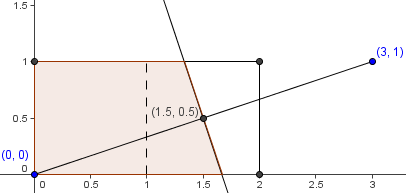Difference between revisions of "2002 AMC 12B Problems/Problem 18"
(template) |
(s) |
||
| Line 1: | Line 1: | ||
== Problem == | == Problem == | ||
| − | A point <math>P</math> is randomly selected from the [[rectangle|rectangular]] region with vertices <math>(0,0),(2,0),(2,1),(0,1)</math>. What is the [[probability]] that <math>P</math> is closer to the origin than it is to the point <math>(3,1)</math>? | + | A point <math>P</math> is randomly selected from the [[rectangle|rectangular]] region with vertices <math>(0,0),(2,0),(2,1),(0,1)</math>. What is the [[probability]] that <math>P</math> is closer to the [[origin]] than it is to the point <math>(3,1)</math>? |
| − | <math>\mathrm{(A)}\ | + | <math>\mathrm{(A)}\ \frac 12 |
| − | \qquad\mathrm{(B)}\ | + | \qquad\mathrm{(B)}\ \frac 23 |
| − | \qquad\mathrm{(C)}\ | + | \qquad\mathrm{(C)}\ \frac 34 |
| − | \qquad\mathrm{(D)}\ | + | \qquad\mathrm{(D)}\ \frac 45 |
| − | \qquad\mathrm{(E)}\ </math> | + | \qquad\mathrm{(E)}\ 1</math> |
== Solution == | == Solution == | ||
| − | {{ | + | [[Image:2002_12B_AMC-18.png]] |
| + | |||
| + | The region containing the points closer to <math>(0,0)</math> than to <math>(3,1)</math> is bounded by the [[perpendicular bisector]] of the segment with endpoints <math>(0,0),(3,1)</math>. The perpendicular bisector passes through midpoint of <math>(0,0),(3,1)</math>, which is <math>\left(\frac 32, \frac 12\right)</math>, the center of the [[unit square]] with coordinates <math>(1,0),(2,0),(2,1),(1,1)</math>. Thus, it cuts the unit square into two equal halves of area <math>1/2</math>. The total area of the rectangle is <math>2</math>, so the area closer to the origin than to <math>(3,1)</math> and in the rectangle is <math>2 - \frac 12 = \frac 32</math>. The probability is <math>\frac{3/2}{2} = \frac 34 \Rightarrow \mathrm{(C)}</math>. | ||
== See also == | == See also == | ||
Revision as of 12:36, 19 January 2008
Problem
A point ![]() is randomly selected from the rectangular region with vertices
is randomly selected from the rectangular region with vertices ![]() . What is the probability that
. What is the probability that ![]() is closer to the origin than it is to the point
is closer to the origin than it is to the point ![]() ?
?
![]()
Solution
The region containing the points closer to ![]() than to
than to ![]() is bounded by the perpendicular bisector of the segment with endpoints
is bounded by the perpendicular bisector of the segment with endpoints ![]() . The perpendicular bisector passes through midpoint of
. The perpendicular bisector passes through midpoint of ![]() , which is
, which is ![]() , the center of the unit square with coordinates
, the center of the unit square with coordinates ![]() . Thus, it cuts the unit square into two equal halves of area
. Thus, it cuts the unit square into two equal halves of area ![]() . The total area of the rectangle is
. The total area of the rectangle is ![]() , so the area closer to the origin than to
, so the area closer to the origin than to ![]() and in the rectangle is
and in the rectangle is ![]() . The probability is
. The probability is ![]() .
.
See also
| 2002 AMC 12B (Problems • Answer Key • Resources) | |
| Preceded by Problem 17 |
Followed by Problem 19 |
| 1 • 2 • 3 • 4 • 5 • 6 • 7 • 8 • 9 • 10 • 11 • 12 • 13 • 14 • 15 • 16 • 17 • 18 • 19 • 20 • 21 • 22 • 23 • 24 • 25 | |
| All AMC 12 Problems and Solutions | |










